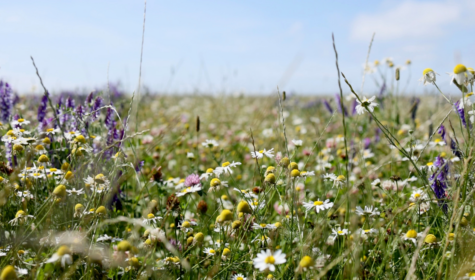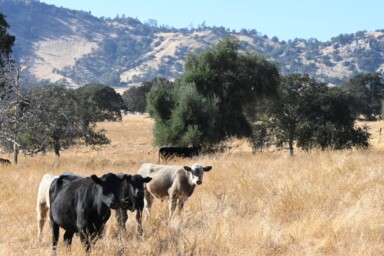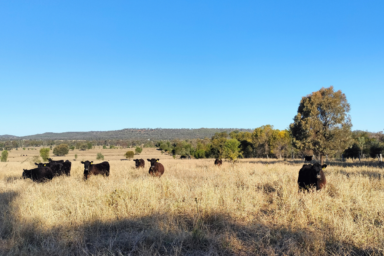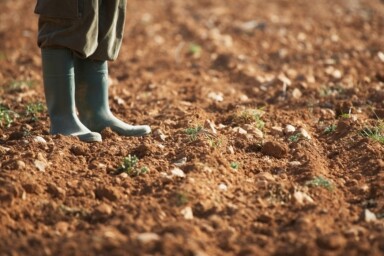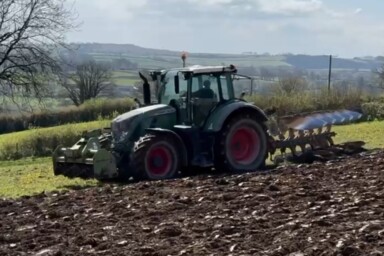Here, our Senior Research Manager, Robert Barbour – who comes from a Perthshire hill-farm – writes about the often overlooked environmental and social benefits that well-managed Scottish grasslands can deliver.
In recent years, Scotland’s grasslands have developed a bit of an image problem. To some, they are largely a wet desert, devoid of biodiversity and in desperate need of a ‘return’ to their original wooded state. To others, they represent an inefficient use of land and would be much better put under forestry or bioenergy crops to help the nation meet its net zero targets. These are, of course, rather crude characterisations of what are often (though not always!) more nuanced positions. Still, a green future for many people is one that will contain much less grassland than today.
Given I come from a hill farming background, it won’t be a surprise to anyone reading this, that I have some misgivings with these arguments. That’s not to say that I completely disagree with them: many of our grasslands are managed in a deeply unsustainable fashion, and for a whole variety of reasons, we need many more trees across our landscape. However, there has been nowhere near enough recognition of the immense contribution grasslands currently make to the nation’s social and environmental fabric, and the huge potential that exists to improve on this.
Grasslands – and the grazing livestock they support – have been fundamentally important to Scotland’s people for millennia. Look at the OS map for the area surrounding our farm in Highland Perthshire, and it is littered with Gaelic placenames related to the keeping of cattle and goats. The goats, and to some extent the cows, have been replaced by sheep in recent times, a shift that speaks to the widespread social, cultural and ecological degradation that has occurred thanks to more than two centuries of Highland Clearances, followed by agricultural intensification. Still, that doesn’t change the fact that livestock grazing remains the key agricultural activity across much of Scotland – now, as then, because our challenging environment renders most of the land area largely unsuitable for cropping. The meat and milk produced from these otherwise unyielding lands may not be as essential to our survival as they were in centuries past. However, they still represent a very significant source of nutrition – a service I don’t think we should ever take for granted, especially with all the climate-related threats to crop production and food security that are coming our way.
Neither should we forget the wider social value of Scotland’s grasslands. Some of this is easily quantified: grazing livestock are, for example, an important source of employment in rural areas, providing vital economic opportunities in some of the country’s most fragile communities. Other benefits are less tangible, but no less important – from the central importance of crofting to community life in parts of the Highlands and Islands, to the aesthetic and recreational value the public get from pastoral landscapes, grasslands have real cultural significance.
“…many of our grasslands are managed in a deeply unsustainable fashion, and for a whole variety of reasons we need many more trees across our landscape. However, there has been nowhere near enough recognition of the immense contribution grasslands currently make to the nation’s social and environmental fabric, and the huge potential that exists to improve on this.”
Well-managed grasslands don’t just provide benefits for people. Temporary grasslands, in the form of fertility-building leys, play a key role in more environmentally sustainable arable systems that don’t rely on costly, fossil fuel-dependent agrichemicals. They also store more soil carbon than conventional all-arable rotations, bringing a host of benefits, including climate mitigation and adaptation. Permanent grasslands are an even more significant store of carbon, of huge importance for climate and freshwater regulation, especially when they are more extensively managed and support a diversity of plant species.
This raises one of the most important but frustratingly overlooked ecosystem services delivered by well-managed grasslands and grazing animals – biodiversity. It’s a benefit I see clearly at home, with half of our family farm designated as an SSSI because of the mix of species-rich upland habitats that cover our hill ground. The alkaline fens and calcareous grasslands are particularly important in a Scottish context, thanks to their scarcity and the rare plant and invertebrate species they support.
Walking these areas in the spring, when the curlew, black grouse and skylark fill the air with their calls, or in the summer, when the ground is awash with a profusion of wildflowers, is an experience that’s pretty difficult to beat. I’m incredibly fortunate to have it on my doorstep – but this biodiversity doesn’t exist in a vacuum, it relies on good grazing management, particularly by cattle, to keep the sward open while avoiding overgrazing of sensitive species.
This doesn’t just apply to the habitats found on our farm: well-managed grazing is a key conservation tool not just for semi-natural grasslands, but also heathlands and some wetland habitats. Grazing livestock can even have a positive influence in native woodlands, reflecting the important role that grazing by large herbivores plays in the ecology of many wooded habitats.
Sadly, decades of agricultural intensification mean that the biodiversity benefits of well-managed grazing have, in all too many instances, been lost. Species-rich grasslands today cover just a fraction of their former area, with most converted to improved pasture or arable land over the past century. And across many of the areas of semi-natural habitats that remain, overgrazing has been, and in many places continues to be, a problem. However, the ongoing loss of livestock from the hills has also seen undergrazing becoming an increasingly serious threat. The loss of hill cattle, due to hill farming’s ongoing lack of profitability and the longer-term shift from mixed cattle and sheep to sheep-only systems, is a particular concern from a biodiversity perspective.
So, what can we do to support our beleaguered grassland biodiversity? Protecting and restoring our remaining semi-natural habitats has to be one of our top conservation priorities. This will require the usual sort of actions – a more holistic approach to land use decision making and well-paid conservation grazing schemes, for instance – but it will also need a robust and sustainable ruminant sector, supported by a network of small abattoirs. This is, remarkably, a condition underpinning the good management of semi-natural grasslands and other habitats that is often overlooked.
This question doesn’t just apply to semi-natural grasslands – there is huge scope for more sustainable management of grasslands that have been agriculturally improved. We’ve certainly seen the benefits of a lower input approach to managing our farm’s improved pastures over recent years: introducing clover into our swards, moving to a mixed species rotational grazing system with fewer sheep, and planting areas of wood pasture, have all delivered major environmental benefits, as well as improvements in profitability. On lower, better ground than ours, moving away from highly intensive ruminant systems reliant on large quantities of bought-in feed and fertiliser – to an approach where output is more determined by the natural carrying capacity of the land – would also help biodiversity by reducing the terrible problem of nitrogen pollution.
“Protecting and restoring our remaining semi-natural habitats has to be one of our top conservation priorities. This will require the usual sort of actions – a more holistic approach to land use decision making and well-paid conservation grazing schemes, for instance – but it will also need a robust and sustainable ruminant sector, supported by a network of small abattoirs.”
We know that we can manage our grasslands in a way that works for rural communities and the environment alike. But major changes need to take place to allow this to happen, perhaps the most important being government support for sustainable grassland management – something that at present is sorely lacking, particularly when compared with woodlands and peatlands. Without this, sustainable grassland management will prove an impossibility for most, and we may well see the loss of many of our grassland farms and the services they provide – an outcome I passionately feel we must strive to avoid, for the future of Scotland’s people and the environment.
